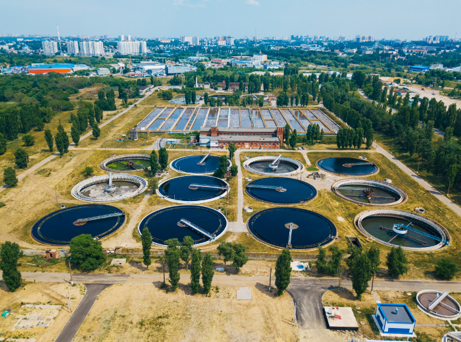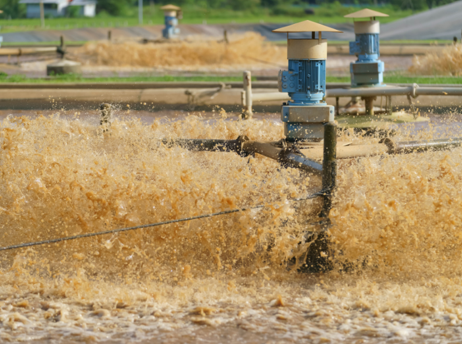3. Visit a sewage treatment plant. It could be as exciting and enriching as a visit to a zoo, a museum, or a park. To guide your observation here are a few suggestions.
Record in your notepad:
Place ___________ Date ___________ Time ___________
Name of the official at the plant __________ Guide/Teacher ___________
(a) The location of the sewage plant.
(b) Treatment capacity.
(c) The purpose of screening as the initial process.
(d) How is air bubbled through the aeration tank?
(e) How safe is the water at the end of the treatment? How is it tested?
(f) Where is the water discharged after treatment?
(g) What happens to the plant during heavy rains?
(h) Is biogas consumed within the plant or sold to other consumers?
(i) What happens to the treated sludge?
(j) Is there any special effort to protect nearby houses from the plant?
(k) Other observations.
Answer:
Here are the details from our visit to a hypothetical municipal sewage treatment plant:
Place: Hypothetical Subdivision of Delhi Date: 5th January 2023 Time: 3:00 pm
Name of the official at the plant: Mr Jagat Nair Guide/Teacher: Mr Narayan Srinivasan
A picture of the plant is shown below:

(a) The location of the sewage plant.
The sewage plant was located in a hypothetical subdivision of Delhi.
(b) Treatment capacity.
The plant is capable of treating 500 million litres of wastewater per day.
(c) The purpose of screening as the initial process.
The purpose of using bar screens to separate large objects like rags, sticks, cans, plastic packets, napkins etc which are unable to pass through and get separated.
(d) How is air bubbled through the aeration tank?
Air is bubbled through the aeration tank using surface aerators. The surface aerator floats in water and is equipped with a motor which vigorously agitates the water. This helps to introduced oxygen inside the water which helps aerobic bacteria grow. The specific model of surface aerator used in the plant is shown below:

(e) How safe is the water at the end of the treatment? How is it tested?
99% impurities were removed after completion of the entire treatment process. Tests for solids, organic matter, pathogens, nutrients, chemicals etc were conducted in a certified laboratory using analysis tools.
(f) Where is the water discharged after treatment?
After treatment the clean water is discharged via a pressurized system of pipes into local waterways for supplying drinking water and irrigation purposes.
(g) What happens to the plant during heavy rains?
Stormwater might increase the amount of impurities in the water and also raise the rate of flow of the water to the plant. This will result in incomplete removal of impurities and hence the impurities present in the water after treatment might be higher than normal.
(h) Is biogas consumed within the plant or sold to other consumers?
The amount of biogas generated is 10 times the amount of energy needed for operating the plant. A portion of the gas was used to meet the energy requirements of certain processes inside the plant itself. This was done using special equipment. The rest of the biogas was legally commercialized and dols to various industries.
(i) What happens to the treated sludge?
The treated sludge is safe to use as landfill and as manure to provide nutrients to plants.
(j) Is there any special effort to protect nearby houses from the plant?
A buffer zone was created to separate the plant from the surrounding houses. Noise barriers and odour control systems were installed to protect nearby houses from pollution. The infrastructure was periodically checked and properly maintained to ensure safety. Special regulations were put in place to ensure compliance with standards for emissions, effluent discharge etc.
(k) Other observations.
The equipment was very modern and highly effective. In some places there were foul odours due to the decomposition process. There were safety signs, warnings, and the plant staff wore protective equipment.
“Visit a sewage treatment plant. It could be as exciting and enriching as a visit to a zoo, a museum, or a park. To guide your observation here are a few suggestions.
Record in your notepad:
Place ___________ Date ___________ Time ___________
Name of the official at the plant __________ Guide/Teacher ___________
(a) The location of the sewage plant.
(b) Treatment capacity.
(c) The purpose of screening as the initial process.
(d) How is air bubbled through the aeration tank?
(e) How safe is the water at the end of the treatment? How is it tested?
(f) Where is the water discharged after treatment?
(g) What happens to the plant during heavy rains?
(h) Is biogas consumed within the plant or sold to other consumers?
(i) What happens to the treated sludge?
(j) Is there any special effort to protect nearby houses from the plant?
(k) Other observations.” – Solved.
Related Links:
Solution to Extended Learning Problem 1
Solution to Extended Learning Problem 2
Solution to Extended Learning Problem 3
Solution to Activity 13.1
Solution to Activity 13.2
Solution to Activity 13.3
Solution to Activity 13.4


